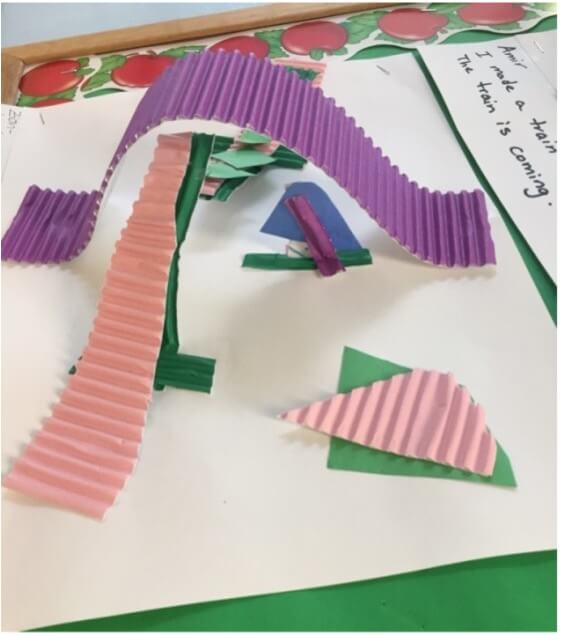Overview
“Looking at something from more than one point of view is a life skill.”
—Cathy Topal Weissman and Lella Gandini
Materials
- White paper, 80 lb., 12×18″
- Trays with an assortment of pre-cut strips of construction paper
- Assortment of pre-cut strips of corrugated paper (optional)
- Soufflé cups of glue
- Craft sticks
Activities
Step 1: Invitation to Explore
- Place the tray with strips of paper and base paper in front of you.
- What do you see on my tray?
- We can use paper to make artwork that is flat, like a collage. Hold up a collage and emphasize that the collage is flat, two-dimensional.
- Let’s make another kind of art with the paper standing up! How do you think we can make the paper stand up?
- Ask students to demonstrate how to change the paper to make it stand-up: fold, bend, roll, and twist.
- How can we make these stay standing on our base?
- What helps us to stand up? Our feet! How do you think we can give the strips of paper feet? Ask for suggestions and then model how to fold the ends of the strips giving them “feet.”
- How, do you think, we can attach the standing paper to the base?
- Model gluing the feet to the paper and sing the gluing song aloud, “dip, dip, dip, wipe, wipe, wipe, and spread, spread, spread like butter on bread.”
- Invite some students to add strips. Where can we place another strip of paper? Encourage placing them over, under, through, and around.
- What do you notice about this?
- Let’s look at this from all sides. Turn the piece around, and ask what students notice.
- Imagine you are a tiny person walking around this. You can go over a strip, under it, on top of it, etc.
- When you can look at a work of art from all sides, you are exploring a work of art that is three-dimensional.
- Ask students to name objects in the classroom that are 3D.
- I wonder what we call a work of art that has a top, bottom, and sides?
- We have created a paper sculpture!
- Let’s all go create paper sculptures!
Step 2: Work-time
- Invite students to begin making their own sculptures.
- Remind students to write their name on the back of their base paper before they begin.
- Circulate the room and observe students as they begin to work. Some students may need help folding, gluing, and arranging their strips of paper. Often peers offer to help one another.
- You may have to remind students about the gluing routine, “dip, dip, tap, tap,” as they work.
- Comment about where students are placing the colored paper strips: over, around, and under. For example, “I noticed you put a red strip over a blue strip.”
- When students have finished working on their paper sculptures, leave them on the tables.
Step 3: Reflection
- This lesson is a perfect opportunity for a “gallery walk.”
- Explain to the students that the best way to view three-dimensional artwork is to walk around the classroom, and to look at the sculptures from all angles.
- Tell students to form a single file line. Explain that they will walk around the classroom and look at each other’s sculptures.
- Before the “gallery walk” begins, explain to the students that they should look carefully at the works of art and notice a part of a sculpture that is different from their own. For example, perhaps a student has twisted a strip of paper around another strip of paper or folded their strip of paper like a staircase.
- Notice the many different approaches to making paper sculpture.
- Ask a few students to share their observations with the group.
Tips
- Save examples of 2D collages so you have examples to refer to during the engagement portion of the lesson.
- Make sure to allow ample time for students to explore different ways of making the paper stand up. This is an ideal time to observe problem-solving in action.
- This exploration is scissors-free! Do not pass out scissors. Observe the many different ways students manipulate their paper. Resist requests for scissors!
- Offer help to students who might be struggling to glue down one part of the paper strip while trying to hold on to another part of the paper. If you can help at the beginning of the exploration, students are more likely to remain engaged and interested in creating the collage.
- You may want to implement a “turn and talk” reflection strategy for this activity. Students can walk around the classroom in pairs. For example, they can find a sculpture that they find interesting and talk about it with a partner.
- This lesson is perfect for a group activity or a parent workshop.
Vocabulary
Three-dimensional, two-dimensional, sculpture, under, over, around, next to, on top of, fold, bend, twist

